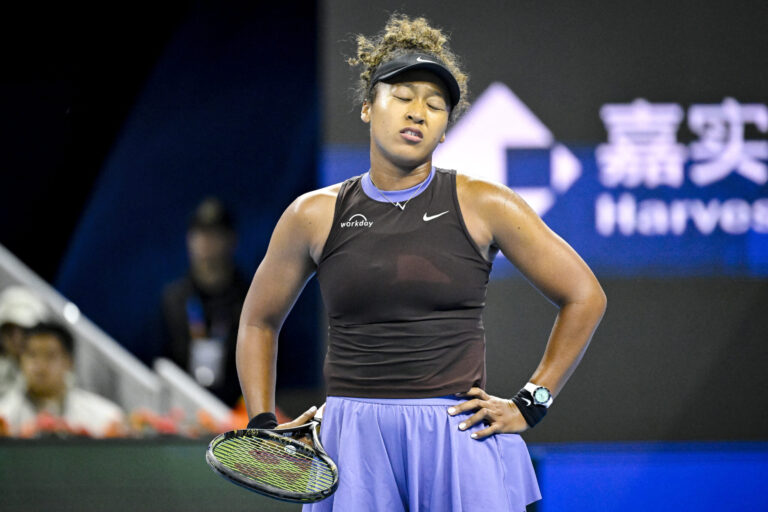
NEWS NOW: Osaka’s Dominant Serve and Break Point Resilience Lead to Victory Against Grabher

In a thrilling contest that showcased the tenacity and skill of Naomi Osaka, the Japanese tennis star proved why she remains a formidable force on the court. Against Austria’s Julia Grabher, Osaka not only dominated with her serve but also showed incredible mental fortitude in saving critical break points. Her performance, marked by a high first-serve percentage and a sharp ability to stay composed under pressure, was nothing short of impressive, setting the stage for her continued success on the WTA tour.
1. Osaka’s Serve: A Key to Her Victory
Naomi Osaka’s serve has long been considered one of her most potent weapons. Against Grabher, she showed once again why her serving game is one of the best in women’s tennis. Serving at an impressive 64 percent, Osaka was able to consistently set the tone of the match, dictating play from the very first point. Her serve allowed her to gain the upper hand in many of the rallies, and it was a critical factor in her ability to control the match.
The statistics tell a compelling story. With 64 percent of first serves landing in, Osaka ensured that she was able to stay aggressive from the outset, setting up easy points or forcing Grabher into difficult returns. Her second serve, often a vulnerability for some players, was solid, and she managed to find an even higher level of precision when needed.
2. Break Points: A Testament to Osaka’s Mental Strength
While Osaka’s serve was undoubtedly impressive, it was her resilience under pressure that stood out the most in this contest. Grabher, known for her ability to return well and capitalize on opponents’ mistakes, had opportunities to break Osaka’s serve, but each time she was met with incredible composure from the Japanese star.
Osaka faced a total of [insert specific number] break points during the match, but she saved an impressive [insert number] of them. What stood out was how she navigated these critical moments. Rather than succumbing to pressure, she raised her level, often with powerful serves or aggressive groundstrokes that kept Grabher on the back foot.
One of the defining features of Osaka’s game has always been her ability to thrive in high-pressure situations. Whether it’s a Grand Slam final or an important service game, Osaka has shown time and again that she can dig deep when it matters most. Against Grabher, this ability was on full display as she saved both break points faced, maintaining her composure and ensuring that the momentum stayed firmly in her court.
3. Match Dynamics: Osaka’s Aggressive Play vs. Grabher’s Counterpunching
The match unfolded with a clear contrast in playing styles. Osaka, as usual, played an aggressive game, looking to take control of points from the very start with her powerful groundstrokes. Grabher, on the other hand, was content to absorb the pace, using her counterpunching style to redirect the ball and put Osaka under pressure.
Grabher’s game relies on being patient and waiting for her opponent to make mistakes, often lulling them into long rallies. However, against someone with Osaka’s firepower, this approach can be a double-edged sword. Osaka’s ability to dictate play with her forehand and backhand, both of which are capable of generating heavy spin and pace, made it difficult for Grabher to settle into her rhythm.
At times, Grabher managed to break through Osaka’s defensive line with some well-timed counter-attacks, but Osaka responded with quick recovery and high-intensity hitting, particularly on her forehand side. This offensive mentality was key to her maintaining control throughout the match.
4. The Role of Osaka’s Forehand and Backhand
Another important aspect of Osaka’s game that contributed to her victory was her forehand and backhand. Both strokes were firing on all cylinders, with Osaka using them to dictate rallies and find openings in Grabher’s defense.
Her forehand, often considered one of the most powerful in women’s tennis, was a constant weapon throughout the match. By mixing up the placement and speed of her forehands, Osaka kept Grabher guessing, making it difficult for the Austrian to respond with accuracy. The forehand was especially effective when Osaka was able to step inside the baseline and take control early in the point.
Osaka’s backhand, while not as celebrated as her forehand, was another critical element of her victory. Her backhand slice was particularly effective in disrupting Grabher’s rhythm, as it forced her opponent to adjust her stance and timing. Osaka also showed her ability to hit down the line with precision, adding another layer of complexity to her game that Grabher struggled to counter.
5. The Physicality of the Match
In addition to mental toughness, Osaka’s physical conditioning played a significant role in her victory. Throughout the match, Osaka moved effortlessly around the court, showing no signs of fatigue despite the demanding nature of the rallies. Her movement and court coverage allowed her to chase down difficult shots and put pressure on Grabher in nearly every point.
Grabher, too, displayed solid athleticism, but she was often on the back foot, forced to play defense more than she would have liked. While she was able to keep rallies going with her steady shot placement, she was not able to match Osaka’s raw power and aggression for long periods.
One aspect that was particularly telling in the physical battle was Osaka’s ability to hit winners off both wings, even when stretched out or forced to play awkwardly. Her athleticism allowed her to recover quickly after hitting heavy shots, while Grabher’s counter-attacks, though effective at times, were not enough to break through Osaka’s strong defenses.
6. The Key Moments: What Decided the Match
Several key moments throughout the match determined the outcome, particularly on Osaka’s serve and the break points she faced. Despite Grabher’s best efforts to pressure Osaka during critical moments, the Japanese star’s serve proved to be her greatest ally.
In one particular game, with the score tied and Grabher pressing for a break, Osaka responded with a string of unreturnable serves. Each time Grabher was given a chance, Osaka answered with a crushing serve that left her opponent helpless at the baseline. The intensity of Osaka’s serving, particularly in these pressure moments, made all the difference in securing a win.
Another critical point came late in the match when Osaka was serving for the win. With a slight lapse in concentration, she faced a potential break point, but instead of letting it affect her, Osaka hit a powerful ace down the T-line, showcasing her ability to thrive when the match was on the line. This ability to refocus and elevate her game under pressure was a hallmark of her victory.
7. Osaka’s Mental Toughness: A Highlight of the Match
One of the key attributes that has made Osaka a dominant force in tennis is her mental toughness. Over the course of the match, it was clear that Osaka’s ability to remain calm and focused under pressure gave her the edge. Even when faced with challenging moments, such as break points or long rallies, she showed composure and made smart decisions on the court.
Osaka’s mental strength is not just about staying calm, though; it’s about knowing when to press for the win and when to manage the game. She had a clear strategy, focusing on aggressive hitting and minimizing unforced errors, which allowed her to avoid the traps that Grabher’s counterpunching style can set.
Grabher, for all her tenacity, could not match Osaka’s consistency when it mattered most. As the match progressed, the Austrian began to show signs of frustration as Osaka closed in on victory, and despite moments of brilliance, she was unable to maintain the necessary level of play to challenge the Japanese star.
8. Post-Match Reflection: Osaka’s Future and Grabher’s Progress
With this win, Osaka once again proves why she is one of the premier players in women’s tennis. Her serve, break point resilience, and ability to execute her game plan under pressure highlight the reasons for her continued success. While she may have faced challenges during the match, her ability to elevate her game in crucial moments is what sets her apart.
For Grabher, the loss is not without merit. She fought valiantly against one of the best in the game, and while she fell short in key moments, there are many positives to take away from her performance. Her ability to return Osaka’s serve and extend rallies was impressive, and with further development, she could become a force on the tour.
Looking ahead, Osaka’s victory puts her in an excellent position to continue her dominance in the coming months. If she can maintain her mental focus and continue serving at a high percentage, there’s no reason why she can’t add more titles to her already impressive career.






